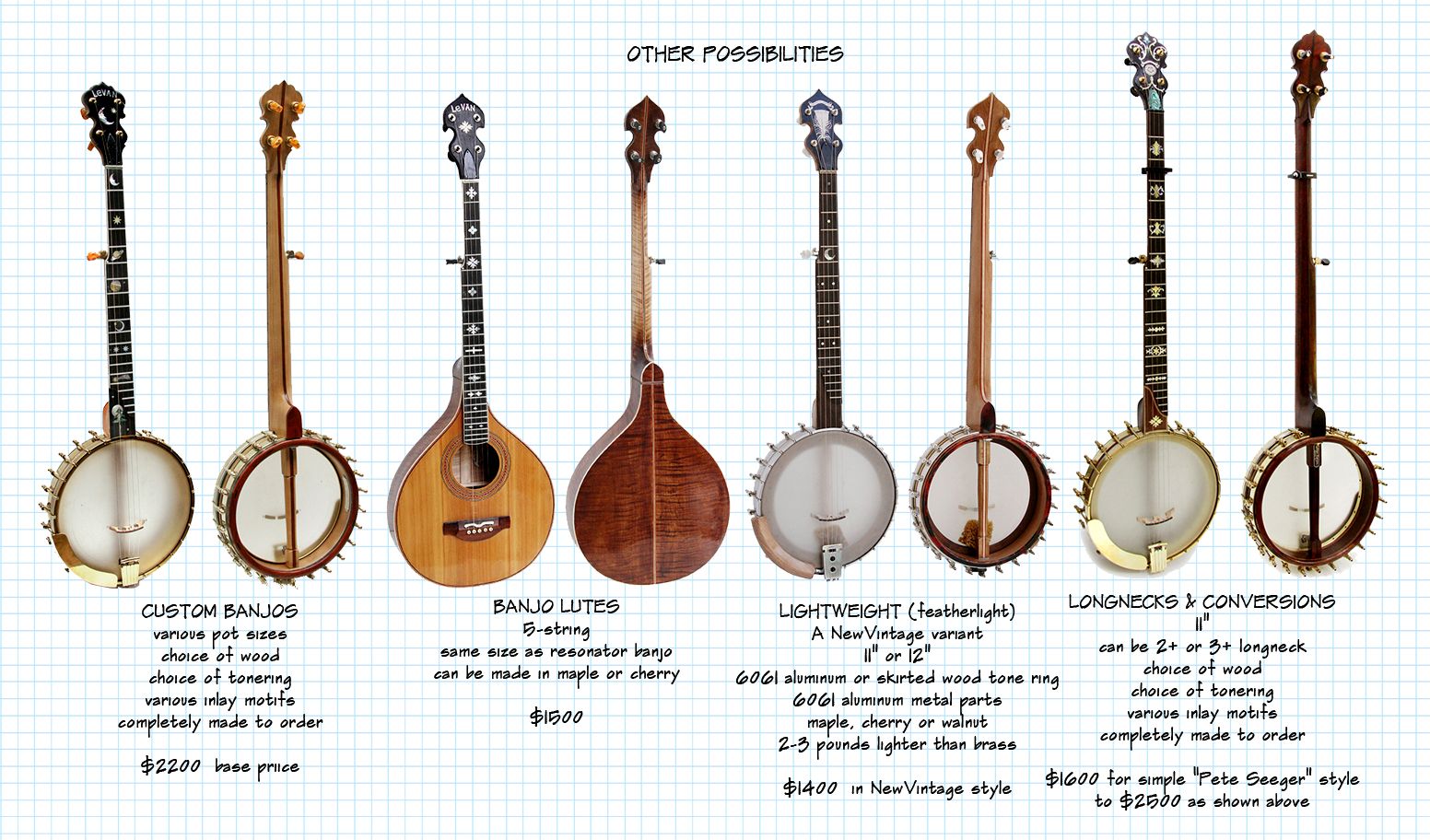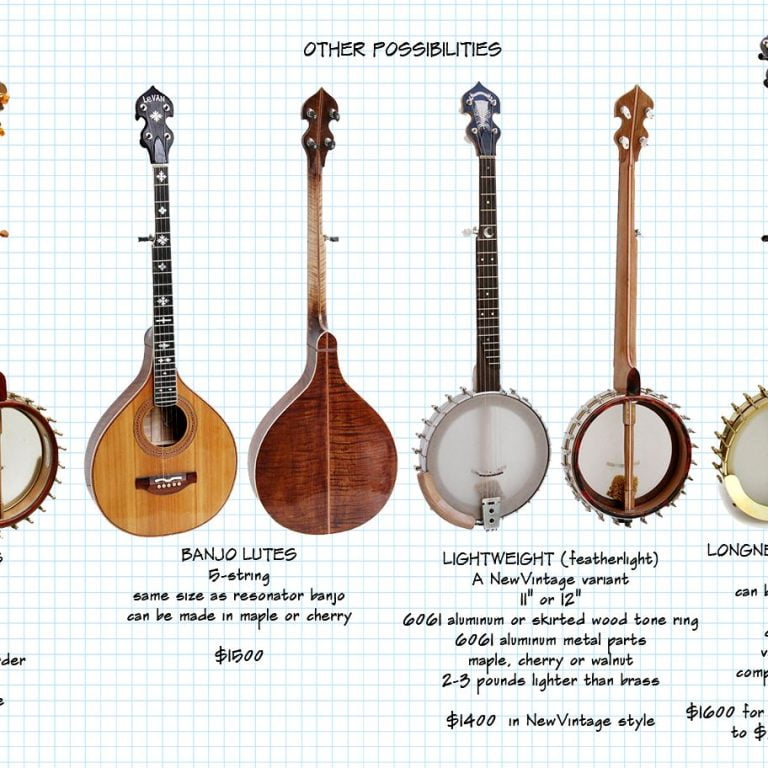When choosing between banjo and ukulele, consider the sound, style, and playing technique. Both instruments have distinct tones and are popular in different music genres.
The banjo is known for its bright, twangy sound and is commonly used in folk and bluegrass music. On the other hand, the ukulele has a softer, more mellow tone and is often associated with Hawaiian and pop music. Additionally, the ukulele is easier to learn for beginners due to its smaller size and fewer strings.
Understanding these differences can help you make an informed decision based on your musical preferences and playing style. Whether you’re drawn to the lively, rhythmic strumming of the banjo or the gentle, melodic tunes of the ukulele, both instruments offer a unique and enjoyable playing experience.
Table of Contents

Credit: capstonemusic.ca
Origins And Brief History of Banjo and Ukulele
The banjo and ukulele are both string instruments with unique characteristics and histories that have played significant roles in various musical traditions. Understanding the origins and brief history of these instruments can provide insight into their cultural significance and evolution over time.
Brief History Of The Banjo

The banjo has roots in West Africa, where similar instruments with gourd bodies and skin drumheads were used in traditional music. The banjo as it is known today evolved from these early instruments and was brought to the Americas by African slaves. It gained popularity in the United States, particularly in Appalachian and African American musical traditions, and has been a key instrument in the development of various genres such as bluegrass, folk, and country music.
Origins And Cultural Significance Of The Ukulele
The ukulele originated in the 19th century in Hawaii, where it was introduced by Portuguese immigrants. Its name translates to “jumping flea” in Hawaiian, reflecting the lively and vibrant nature of its sound. The ukulele quickly became synonymous with Hawaiian music and hula dancing, and it has since spread to become a popular instrument in many musical styles worldwide.
Evolution Of Both Instruments Over Time
As times have changed, both the banjo and ukulele have evolved in terms of design, construction, and the techniques used to play them. They have also expanded beyond their original cultural boundaries to become integral to a wide range of musical genres, demonstrating their enduring relevance and adaptability in the world of music.
Difference Between Banjo And Ukulele

The banjo and ukulele are both stringed musical instruments, but they have several key differences in terms of their origin, construction, tuning, playing style, and sound. Here are some of the main distinctions between the banjo and ukulele
1. Origin:
- Banjo: The banjo has African roots and evolved from various African instruments. It gained popularity in the United States, particularly in the Appalachian region, during the 19th century.
- Ukulele: The ukulele originated in the 19th century in Hawaii. It is derived from the Portuguese machete, a small guitar-like instrument brought to the islands by Portuguese immigrants.
2. Construction:
- Banjo: The banjo typically has a circular body with a membrane (usually made of animal skin or synthetic materials) stretched across it. It has a long neck with frets and five or more strings. The strings are often plucked or strummed with a finger or a pick.
- Ukulele: The ukulele usually has a small, guitar-shaped body with a soundboard made of wood. It has four strings, traditionally made of gut, but modern ukuleles often have nylon or synthetic strings. The ukulele’s neck is shorter than that of a banjo and is fretted.
3. Tuning:
- Banjo: Banjos are typically tuned to open G, open D, or other tunings depending on the style and player preference.
- Ukulele: The standard tuning for a ukulele is G-C-E-A, with the G string being the highest pitch.
4. Playing Style:
- Banjo: Banjos are played using various techniques, including fingerpicking, clawhammer, and three-finger picking styles. The playing style can vary between traditional and more modern techniques.
- Ukulele: The ukulele is often strummed or picked using fingers or a pick. It is known for its light, rhythmic, and melodic qualities.
5. Sound:
- Banjo: The banjo has a bright and twangy sound, often associated with folk, bluegrass, and country music.
- Ukulele: The ukulele has a softer and sweeter sound. Which is well-suited for a variety of musical genres, including Hawaiian music, pop, and folk.
6. Popular Genres:
- Banjo: Commonly associated with bluegrass, folk, country, and traditional Appalachian music.
- Ukulele: Often heard in Hawaiian music. But it has become popular in a wide range of genres, including pop, rock, and folk.
In summary, while both the banjo and ukulele are stringed instruments, they have distinct characteristics in terms of origin, construction, tuning, playing style, and sound, making them unique and versatile in their own ways.
Design And Construction
Design and construction play a vital role in creating the distinct sounds and playability of banjos and ukuleles. Variations in their design and materials impact the overall performance and characteristics of these instruments.
Variations In Banjo Design And Materials
Banjos come in various designs and construction materials, affecting their tone and playability. The most common types of banjos include the 4-string tenor banjo, 5-string bluegrass banjo, and 6-string banjo. These variations cater to different playing styles and musical genres. Additionally, banjos can be constructed with different resonator materials such as wood, metal, or plastic, each contributing to the instrument’s tonal qualities and projection.
Different Types Of Ukuleles And Their Construction
Ukuleles, on the other hand, are available in different types such as soprano, concert, tenor, and baritone ukuleles, each differing in size and scale length. The construction of ukuleles involves various types of tonewoods, including mahogany, koa, and spruce. The choice of tonewood impacts the ukulele’s resonance and tonal characteristics, leading to distinct sounds across different models.
How The Design Impacts Sound And Playability
The design and construction of both banjos and ukuleles significantly impact their sound and playability. For banjos, the choice of materials for the rim, resonator, and neck determines the instrument’s brightness, sustain, and overall tonal profile. Similarly, the type of tonewood used in ukuleles, along with their body shape and size, greatly influences their resonance, warmth, and projection, ultimately affecting the player’s experience.
Sound And Tone
When it comes to comparing the sound of banjo and ukulele, it’s essential to delve into their unique tonal characteristics. Both instruments offer distinct timbres and qualities that contribute to their individual charm and versatility. The sound and tone of banjo and ukulele are influenced by various factors. The type of strings, body construction, and playing techniques, making it an intriguing comparison for musicians and enthusiasts alike.
Comparing The Sound Of Banjo And Ukulele
The sound of banjo is characterized by its bright, metallic tones and distinctive twang, owing to the resonating drum-like structure of the body. On the other hand, ukulele produces a warm, mellow sound, attributed to its smaller body size and nylon strings. The banjo’s plucky, percussive effect contrasts with the ukulele’s soft, soothing remusical styles and genres.
Unique Tonal Characteristics Of Each Instrument
Banjo is known for its rich, resonant tone that can range from bright and lively to deep and melancholic, making it a versatile choice for folk, bluegrass, and country music. In comparison, the ukulele exudes a cheerful, melodious quality, perfect for creating a whimsical and upbeat ambiance in Hawaiian, pop, and indie music.
The Role Of Strings, Body, And Construction In Sound Production
Strings: Banjo typically uses metal strings, contributing to its sharp, metallic twang, while ukulele employs softer nylon strings, enhancing its warm, soothing resonance.
Body: The drum-like resonator of the banjo, often made of wood or metal, generates its distinct twang, while the hollow body of the ukulele, crafted from various woods, produces its mellower, harmonic tones.
Construction: The design and construction of the instruments play a crucial role in shaping their sound. The banjo’s open-back or resonator design and the ukulele’s body size and shape significantly influence their tonal characteristics.
Playing Techniques
When it comes to mastering the banjo and ukulele, understanding their playing techniques is crucial for honing your skills and developing your unique musical style. Each instrument has its distinct playing techniques and nuances that shape its sound, making it essential to explore the different fingerpicking styles, strumming patterns, and musical approaches inherent to each. Let’s delve into the notable differences in playing techniques between the banjo and ukulele and explore how these aspects influence their musical styles.
Distinct Playing Techniques For Banjo And Ukulele
Both the banjo and ukulele offer unique playing techniques that set them apart from one another. The banjo typically employs a combination of fingerpicking and strumming, while the ukulele utilizes predominantly strumming patterns and fingerpicking, albeit to a lesser extent.
Fingerpicking Styles And Strumming Patterns
The fingerpicking styles for banjo and ukulele differ significantly. The banjo often involves intricate fingerpicking patterns, with players using three fingers (thumb, index, and middle) to pluck the strings, resulting in the distinctive rolling and melodic sounds synonymous with the instrument. On the other hand, ukulele players primarily utilize simple fingerpicking styles combined with a variety of strumming patterns, such as the popular “down-up” strumming technique, to create rhythmic and percussive elements in their music.
Notable Differences In Playing Approach And Musical Styles
When it comes to the playing approach, the banjo requires players to adapt to its unique tuning and fretboard layout, which often involves learning specific chord shapes and fretting techniques suited to the instrument. Conversely, the ukulele’s smaller size and familiar chord shapes make it relatively easier for beginners to pick up and play. Musically, the banjo is associated with genres like bluegrass, folk, and country, where intricate fingerpicking and rhythmic strumming patterns take center stage. Meanwhile, the ukulele is widely recognized for its association with Hawaiian music, pop, and indie genres, often featuring lively strumming patterns and catchy melodies.
Musical Versatility
When it comes to musical versatility, both the banjo and the ukulele offer unique and diverse capabilities that make them popular among musicians and enthusiasts. Let’s explore how each instrument shines in different genres and adapts to various styles of music.
Exploring The Genres Where Banjo Shines
The banjo has a rich history in traditional folk and bluegrass music, where its distinct twang and lively picking style create an authentic and lively sound. Its versatility extends to genres such as country, Americana, and even jazz, allowing it to stand out as a prominent feature in these styles.
Ukulele’s Versatility And Adaptation In Diverse Music Styles
Despite its small size, the ukulele has proven to be remarkably versatile, effortlessly transitioning between styles like Hawaiian, folk, pop, and even rock. Its gentle, melodic tones and easy playability make it an appealing choice for musicians seeking a versatile and accessible instrument.
Crossover Appeal And Adaptability Of Each Instrument
Both the banjo and ukulele have demonstrated their crossover appeal and adaptability in modern music, often being incorporated into unexpected genres such as indie, alternative, and even electronic music. Their unique sounds and adaptability continue to attract a new generation of musicians and listeners alike.
Cultural Significance
Music has always been an integral part of culture, resonating with communities across the globe. Instruments like the banjo and ukulele have carved out their place in history, each with their unique cultural significance and impact.
Influence Of Banjo In Traditional And Folk Music
The banjo has deep roots in traditional and folk music, particularly in American history. Originating from West Africa and brought to the United States by enslaved Africans, the banjo became intertwined with the sounds of Appalachia and the American South. Its distinct twang and rhythmic versatility found a home in genres such as bluegrass, country, and traditional folk music, shaping the sonic landscape of these rich musical traditions.
Ukulele’s Cultural Impact And Association With Hawaiian Music
The ukulele, on the other hand, holds a strong cultural association with Hawaiian music. Introduced to the Hawaiian Islands by Portuguese immigrants in the 19th century, the instrument quickly became a core element of traditional Hawaiian music. Its bright, cheerful tones and iconic sound have come to symbolize the spirit and essence of Hawaiian culture, weaving through chants, hula performances, and the island’s distinctive musical heritage.
Role Of Both Instruments In Popular Culture And Modern Music
While rooted in tradition, both the banjo and ukulele have found a place in modern popular culture and contemporary music. The banjo’s resurgence in genres like indie folk and alternative rock has brought it to new audiences, infusing a timeless quality into current musical expressions. Similarly, the ukulele has experienced a renaissance, with its playful sound and portability making it a favorite in pop, folk, and even rock music, adding a touch of whimsy to modern compositions.
Learning Curve And Accessibility
When considering learning a new instrument, it is essential to assess the learning curve and accessibility. In the case of banjo vs. ukulele, both instruments have their unique characteristics that impact how easily a beginner can pick up and learn to play them. Understanding these factors is vital for anyone considering embarking on their musical journey with either of these two stringed instruments.
Comparing The Learning Curve For Beginners
The banjo and ukulele each present their own learning curves for beginners. While the banjo can be more challenging due to its many strings and complex fingerpicking techniques, the ukulele is typically considered more beginner-friendly and easier to learn. The smaller size, fewer strings, and simpler chord structures of the ukulele make it a popular choice for novices.
Affordability And Accessibility Of Banjo And Ukulele
Both the banjo and ukulele come in a range of price points, making them relatively affordable and accessible to those interested in learning to play. As a beginner, one can easily find budget-friendly options for both instruments, allowing for accessibility regardless of financial limitations.
Resources And Support Available For Learning Each Instrument
When it comes to learning resources and support, both the banjo and ukulele offer a wealth of materials and communities that cater to beginner musicians. Online tutorials, instructional books, and local music classes are readily available for those seeking to learn either instrument. Additionally, online forums and social media groups provide support and encouragement for individuals honing their skills on the banjo or ukulele.
Personal Preference And Application
Trying to decide between the banjo and ukulele for your musical pursuits? Your personal preference and the intended application will play a key role in your decision-making process. The banjo offers a rich, twangy sound, while the ukulele produces a lighter, more melodious tone.
Both instruments have their unique appeal, so consider your musical style and the type of sound you’re aiming for when making your choice.
Factors To Consider When Choosing Between A Banjo And Ukulele
When it comes to selecting the right instrument for your musical journey, there are several factors to consider. The choice between a banjo and a ukulele goes beyond the basic differences in their sound and appearance. The decision often hinges on personal preference, playing style, and the intended application of the instrument.
Both the banjo and ukulele offer unique tonal qualities, playing techniques, and versatility. Understanding the key factors that differentiate the two instruments can help aspiring musicians make an informed decision.
Instances Where One May Be Preferred Over The Other
Each instrument has its own strengths and situations where it may be preferred over the other. For instance, the ukulele is popular for its portability and its association with laid-back, tropical vibes, making it a beloved choice for beachside performances and casual jam sessions. On the other hand, the banjo is often favored in folk, bluegrass, and country music due to its distinct, twangy sound that complements these genres superbly.
Understanding the specific contexts where one instrument shines over the other can help musicians make the right choice for their individual playing preferences and musical goals.
Personal Anecdotes And Insights From Musicians And Enthusiasts
Many musicians and enthusiasts have personal experiences and insights regarding the banjo and ukulele, shedding light on the unique qualities of each instrument from a hands-on perspective. For example, renowned ukulele players often share how the instrument’s compact size and bright, cheerful sound have enriched their performances, while banjo enthusiasts may highlight how the instrument’s rhythmic drive and raw energy elevate their bluegrass band’s sound.
These firsthand accounts offer valuable perspectives that can guide aspiring musicians in making an informed decision about which instrument aligns best with their musical aspirations and personal playing style.
Frequently Asked Questions Of Banjo Vs. Ukulele
What Are The Main Differences Between A Banjo And A Ukulele?
The main differences lie in their size, number of strings, and sound. Banjos typically have 5 strings and produce a twangier, more percussive sound, while ukuleles have 4 strings and a softer, melodic tone.
Which Is Easier To Learn For Beginners, The Banjo Or The Ukulele?
Both instruments are beginner-friendly, but the ukulele is often considered easier due to its smaller size and simpler chord formations. The banjo, with its unique picking and strumming techniques, may require a bit more time to master.
Can A Banjo Be Used To Play The Same Songs As A Ukulele?
While some songs can be played on both instruments, they have distinct sounds and playing styles. Some songs may sound better on a banjo due to its unique sound and vice versa, so it’s worth exploring both instruments for different musical experiences.
Conclusion
In a nutshell, both the banjo and ukulele offer unique characteristics that cater to different musical preferences. By understanding their differences and similarities, you can make an informed decision when choosing the instrument that best suits your style and musical objectives.
Ultimately, whether it’s the lively twang of a banjo or the warm melodies of a ukulele, both instruments have something special to offer.



